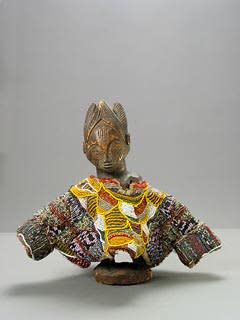Yoruba Ibeji Doll with Beaded Gown, 20th Century CE
Wood, Beads, Cloth
12.25 x 10.75
PF.5733
Further images
Twins are held in high regard in Yoruba society, and are considered to be the children of Shango, god of thunder and lightening. When one twin dies the mother consults...
Twins are held in high regard in Yoruba society, and are considered to be the children of Shango, god of thunder and lightening. When one twin dies the mother consults a diviner who then recommends a carver to make a memorial in the form of a statuette. The finished figure is known as an ibeji, and will be cared for by the mother with the same loving attention as she gives to her surviving twin. This charming female ibeji shows the typical enlarged head, (a sign of spiritual power), with its beautiful striated hairdo composed of a central conical peak and two vertical extensions like wings. Hands are folded over the abdomen, the breasts are prominent pointing downwards. The cloak (ewu) comprises intricate patterns of multi-colored beads in a stunning array. Darker colors dominate the sleeves, while the center and back are full of vivid yellows, reds, gold and white. Beaded work has traditionally been reserved for kings, priests and priestesses of certain gods, and herbalist-diviners; in other words persons who are thought to possess spiritual power. On Shango shrines in Oyo, Iwo and Ila-Orangun can still be seen ibeji statuettes tucked in among the "thunder bolts" in the ritual calabash. (William Fagg, "Yoruba Beaded Work"). It is possible this ibeji was made for a high ranking person who honored and loved it as if it were a living child.







